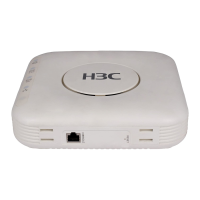7-9
[AP-wlan-st-2]quit
# Create interface WLAN-BSS2, and configure its port priority as 7.
[AP] interface wlan-bss 2
[AP-WLAN-BSS2] qos priority 7
[AP-WLAN-BSS2] quit
[AP] interface wlan-radio 1/0/2
[AP-WLAN-Radio1/0/2] service-template 2 interface WLAN-BSS 2
[AP-wlan-st-2] quit
# Assign interfaces WLAN-BSS 1 and WLAN-BSS 2 to different VLANs, such as VLAN 2 and VLAN 3
respectively.
[AP] vlan 2
[AP-vlan2]quit
[AP] interface WLAN-BSS 1
[AP-WLAN-BSS1] port access vlan 2
[AP-WLAN-BSS1] quit
[AP] vlan 3
[AP-vlan3]quit
[AP] interface WLAN-BSS 2
[AP-WLAN-BSS2]port access vlan 3
[AP-WLAN-BSS2] quit
# Configure port Ethernet 1/0/1 to use the 802.1p priority of received packets for priority mapping, and
configure port Ethernet 1/0/1 as a trunk port.
[AP] interface ethernet 1/0/1
[AP-Ethernet1/0/1] qos trust dot1p
[AP-Ethernet1/0/1]port link-type trunk
# Assign port Ethernet 1/0/1 to VLAN 1 through VLAN 3.
[AP-Ethernet1/0/1] port trunk permit vlan 1 to 3
[AP-Ethernet1/0/1] quit
With these configurations completed, when you copy files to Host A and Host B or load files to Host A
and Host B through the two wireless users connecting to BSS1 and BSS2 respectively, you will find that
the loading rate of the wireless user connecting to BSS2 is faster than the loading rate of the wireless
user connecting to BSS1.
These configurations just apply to the traffic from the wireless network to the wired network. To regulate
the traffic from the wired network to the wireless network, you should make port priority configurations
on the involved ports on the switch.

